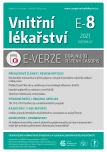Long‑term mechanical circulatory support for chronic heart failure – real life practice
Authors:
Luděk Pavlů 1; Marek Vícha 1; Libor Jelínek 1; Miloš Táborský 1; Jana Petřková 1,2,3
Authors‘ workplace:
I. interní klinika – kardiologická, Lékařská fakulta Univerzity Palackého a Fakultní nemocnice Olomouc
1; Ústav molekulární a translační medicíny, Lékařská fakulta Univerzity Palackého v Olomouci
2; Ústav patologické fyziologie, Lékařská fakulta Univerzity Palackého v Olomouci
3
Published in:
Vnitř Lék 2021; 67(E-8): 3-6
Category:
Review Articles
Overview
Thanks to developments in pharmacological and non-pharmacological treatment of heart failure over the last half century, there has been improved quality of life and reduced mortality and morbidity. Despite these advances, the prognosis of advanced heart failure remains poor and the number of patients with terminal heart failure is currently increasing. In the general medical community, knowledge of pharmacological and device therapy with implantable cardioverter-defibrillator or resynchronization therapy is prevalent. However, only a limited number of professionals, mostly in tertiary centres, have personal experience with the use of long-term mechanical circulatory support (MCS) in patients with advanced heart failure after the above conventional therapeutic options have been exhausted. The purpose of this communication is, therefore, to provide the general medical community with basic information about benefits, limitations and referral strategies for MCS.
Keywords:
therapy – long‑term mechanical circulatory support – advanced heart failure
Sources
1. Khush KK, Cherikh WS, Chambers DC et al. The International Thoracic Organ Transplant Registry of the International Society for Heart and Lung Transplantation: Thirty‑sixth adult heart transplantation report - 2019; focus theme: Donor and recipient size match [published correction appears in J Heart Lung Transplant. 2020 Jan;39(1):91]. J Heart Lung Transplant. 2019; 38(10): 1056–1066.
2. Gibbon JH Jr. Application of a mechanical heart and lung apparatus to cardiac surgery. Minn Med. 1954; 37(3): 171–185.
3. Rose EA, Gelijns AC, Moskowitz AJ et al. Long‑term use of a left ventricular assist device for end‑stage heart failure. N Engl J Med. 2001; 345(20): 1435–1443.
4. Netuka I, Ivák P, Tučanová Z et al. Evaluation of low‑intensity anti‑coagulation with a fully magnetically levitated centrifugal‑flow circulatory pump‑the MAGENTUM 1 study. J Heart Lung Transplant. 2018 May; 37(5): 579–586.
5. Mehra MR, Uriel N, Naka Y et al. A Fully Magnetically Levitated Left Ventricular Assist Device – Final Report. N Engl J Med. 2019 Apr 25; 380(17): 1618–1627.
6. ISHLT Transplant Registry Quarterly Reports for Heart in Europe based on UNOS/ISHLT data as of Jan 5, 2018
7. Kirklin JK, Naftel DC, Stevenson LW et al. INTERMACS database for durable devices for circulatory support: first annual report. J Heart Lung Transplant. 2008; 27(10): 1065–1072.
8. Ponikowski P, Voors AA, Anker SD et al. 2016 ESC Guidelines for the diagnosis and treatment of acute and chronic heart failure: The Task Force for the diagnosis and treatment of acute and chronic heart failure of the European Society of Cardiology (ESC)Developed with the special contribution of the Heart Failure Association (HFA) of the ESC. Eur Heart J. 2016; 37(27): 2129–2200.
9. Špinar J, Hradec J, Špinarová L et al. Summary of the 2016 ESC Guidelines on the diagnosis and treatment of acute and chronic heart failure. Prepared by the Czech Society of Cardiology. Cor et Vasa 2016; 58(5): e530–e568.
10. McMurray JJV, Solomon SD, Inzucchi SE et al. Dapagliflozin in Patients with Heart Failure and Reduced Ejection Fraction. N Engl J Med. 2019; 381(21): 1995–2008.
11. Ema.europa.eu/medicines/human/EPAR/Forxiga. EMA/84150/2021 (www.ema.europa. eu/en/documents/overview/forxiga‑epar‑medicine‑overview_ en.pdf).
12. Prinzen FW, Vernooy K, Auricchio A. Cardiac resynchronization therapy: state‑of‑the‑art of current applications, guidelines, ongoing trials, and areas of controversy. Circulation 2013; 128(22): 2407–2418.
13. Pya Y, Maly J, Bekbossynova M et al. First human use of a wireless coplanar energy transfer coupled with a continuous flow left ventricular assist device. J Heart Lung Transplant. 2019; 38(4): 339–343.
Labels
Diabetology Endocrinology Internal medicineArticle was published in
Internal Medicine

2021 Issue E-8
Most read in this issue
- Long‑term mechanical circulatory support for chronic heart failure – real life practice
- Tumor induced osteomalacia
- Th1, Th2 and Th17 lymphocytes in autoimmune thyreopathies
- Lethal alcohol intoxications cases: thinking about the causes
